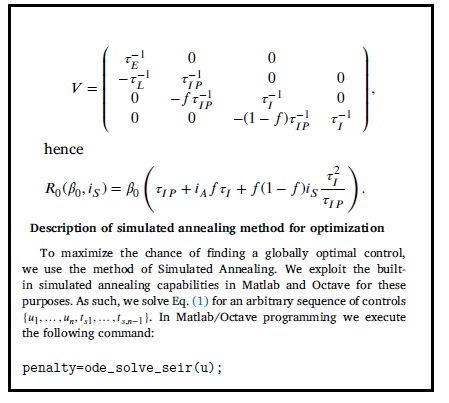Case Studies in Mathematical Modelling

Description: In 2023, these case studies in Mathematical Modelling featured as part of a course in Applied Statistical Modelling. The lecture notes relating to the case studies, as well as various analytical and computational exercises, are posted here, for archival purposes.
Course documents:
- Full set of lecture Notes (January 2023)
Lecture Series 1: Mathematical Epidemiology
In this short series of lectures, we look at the mathematics behind the SIR model. This is the simplest possible model of Mathematical Epidemiology. We look at the model formulation. We do a theoretical analysis of the model. This then enables us to introduce key concepts in epidemiology, such as R0. In a workshop (Lecture 4), we look at how the model can be fitted to data.
Lecture 1: In this brief lecture we look at the model assumptions behind the SIR model and we formulate the model as a set of three coupled ODEs. We discuss the issue of free parameters in the model. Taken from Chapter 3 of the typed notes.
Lecture 2: We carry out a theoretical analysis of the SIR model and introduce the R0 parameter - the basic reproduction number. Taken from Chapter 3 of the typed notes.
Lecture 3: We look at numerical simulations of the SIR model as well as key concepts such as late-stage burnout and the herd-immunity threshold. Taken from Chapter 3 of the typed notes.
Lecture 4: In this short lecture we show how to fit the SIR model to some data for a simulated epidemic. The fitting method is a kind of nonlinear optimization. There are three fitting parameters - including the unknown values of the rates beta and gamma. The optimal parameter values are the ones that minimize the cost function in the nonlinear optimization. We also show how to use statistical bootstrapping to construct confidence intervals for the estimated parameters. Taken from Chapter 4 of the typed notes.
Lecture Series 2: Mathematical Modellling of Pharmacokinetics
In this short series of lectures, we look at simple mathematical models of Pharamacokinetics (PK). These models describe elimination of drugs from the body, as well as metabolism. Using worked examples, we show how the various PK models can be fitted to patient data involving plasma concentration.
Lecture 1: In this brief lecture we look at simple one-compartment models in PK. Taken from Chapter 5 of the typed notes.
Lecture 2: In this lecture we look at one-compartment models in PK involving oral administration. We show how the models can be fitted to pateint data. Taken from Chapter 5 of the typed notes.
Lecture 3: In this lecture we look at more complicated, multi-compartment models in PK. Taken from Chapter 5 of the typed notes.
Lecture 4: We look at the theory of repeated doses in PK. Taken from Chapter 6 of the typed notes.
Group Projects
Mathematical Epidemiology: There will be two main projects on Mathematical Epidemiology. Both main projects will involve the same set of initial tasks, before they branch off at the end and consider two separate datasets. The first task will be to analyze the mathematical properties of an SEIR model with re-infection, to compute the endemic state, the disease-free equilibrium, and the basic reproduction number. The second task will be a computational talsk, where students will be invited to use maximum likelihood estimation to fit such an SEIR model to a dataset for a simulated disease outbreak. The third and final task will be for students to use what they have learned to fit a dynamic model (like SEIR) to a dataset corresponding to a real disease outbreak.
Pharmacokinetics: There will be two main projects in PK. Both main projects will involve the same set of initial tasks, before they branch off at the end and consider two separate datasets. The first task will be to analyze a two-compartment model for oral administration. The second task will be a computational task, where students will be invited to fit a two-compartment model to some patient data, using nonlinear least squares or some other method. The third and final task will be for students to use what they have learned to fit more complicated patient data sets to the various PK models.